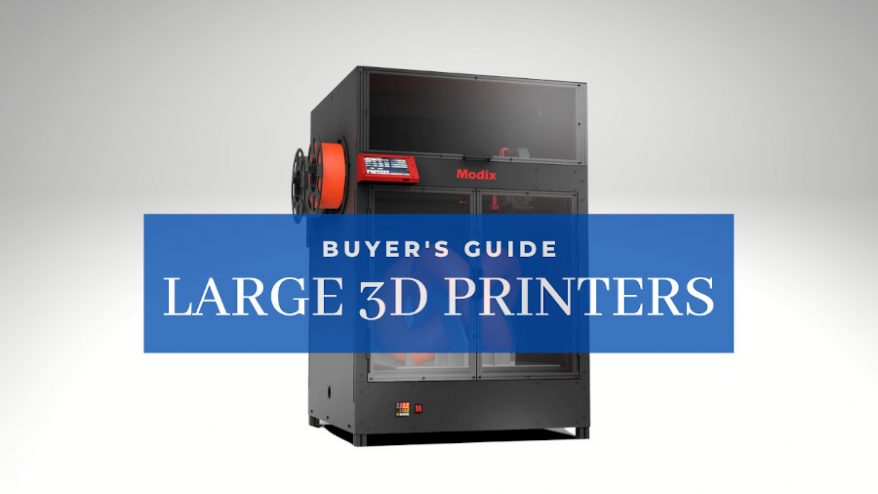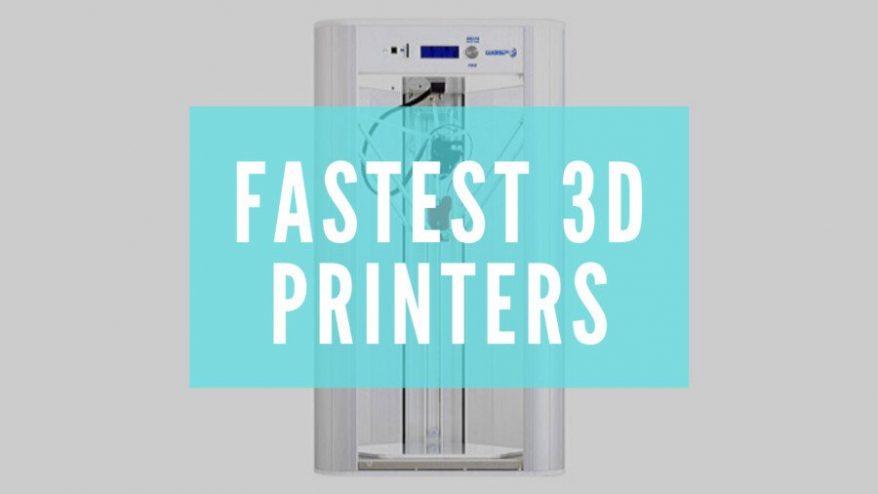Ender 5 vs Ender 5 Plus vs Ender 5 Pro – phew, a bit of a mouthful there, but that’s today’s showdown, a head-to-head between all three of Creality’s entry-level FDM cubic marvels. What sets them apart? Which is the best for your needs? We’re putting them through their paces to answer those very questions and more.
It stands to reason that there is some crossover between all three printers. After all, they all bear the same name. But, with an unbiased approach, we’ll highlight in what way they deviate from one another to help you choose.
After a brief introduction to the Ender 5, Ender 5 Pro, and Ender 5 Plus, we’ll jump into a meat-and-potatoes comparison before dishing out the awards at the end. Let’s jump in.
CONSISTENT PICK

Ender 5 Pro
Available at:
BUILD VOLUME PICK

Ender 5 Plus
Available at:
The Printers
Creality Ender 5
- Price: Difficult to find in stock – Check Amazon store here
- Printing technology: FDM
- Build volume: 220 x 220 x 300 mm
- Filament compatibility: PLA, ABS, TPU, PETG
- Layer height: 100-400 microns
- Printing accuracy: ± 0.1 mm
- Max extruder temp: 260°C
- Max bed temp: 110°C
- Connectivity: USB, SD Card
The Ender 5 base model has mostly been phased out now, so for support and ongoing use, we recommend that you opt for the Ender 5 Pro, or Plus.
Riding the wave of success of the budget benchmark-setting Ender 3, the Ender 5 takes the most loved parts of its siblings alongside several superb enhancements and houses them in a larger cubic frame with a gantry design.
Among the improvements are a just-about-average 220 x 220 x 300 mm build volume, ideal if you want a little more room to play with than the Ender 3. New dedicated stepper motors for each axis improve overall stability and fix the Ender 3’s unfortunate Y-axis wobble issues. A heated C-MAG magnetic build plate powered by a beefy 24V Mean Well PSU ensures speedy bed heating for ABS, PLA, TPU, and PETG printing.
Additional quality of life add-ons like a resume print function, straightforward modular DIY assembly, easy manual bed leveling nuts, neat cabling, and plenty of Creality’s signature mod potential only sweeten the deal here.
In keeping with Creality’s objective to marry affordability with solid performance, the Ender 5’s print quality out of the box is excellent for the price and reliably so even at higher print speeds.
Pros:
- Mod and hack-friendly
- Sturdy frame
- Capable of excellent print quality for the price
- Affordable
Cons:
- Manual bed leveling
- Unremarkable magnetic build plate
Creality Ender 5 Pro
- Price: $379 — Available at Amazon store here
- Printing technology: FDM
- Build volume: 220 x 220 x 300 mm
- Filament compatibility: PLA, ABS, TPU, PETG
- Layer height: 100-400 microns
- Printing accuracy: ± 0.1 mm
- Max extruder temp: 260°
- Max bed temp: 110°
- Connectivity: USB, SD Card
Much like it did with the jump from the Ender 3 to the Ender 3 Pro, Creality took the core experience and feature-set of the Ender 5 and injected several choice upgrades to create the Ender 5 Pro. This printer is very much a souped-up replacement for the original, with only a slight premium tagged on.
So, what do you get for the extra expense? First and foremost, you get the same sleek cube frame, well-sized build volume, and fast bed heating of the original.
From there, the Ender 5 Pro jazzes things up with a new V1.15 silent mainboard with TMC2208 drivers for quiet printing (well, at least quiet by 3D printing standards). There’s now thermal runaway protection in case things get a little too heated, too.
A beefed-up all-metal extruder frame helps smooth filament loading and extrusion consistency with a handy adjustable bolt to fine-tune gear pressure to suit different filament types. And finally, the Ender 5 Pro replaces the plastic tubing for sleek Capricorn Bowden PTFE tubing, raising the printer’s printing chops when using flexibles and cutting down on wiggle and other common filament loading woes.
It’s a tight set of upgrades that prove their worth from the get-go with a better printing experience than the stock Ender 5.
Pros:
- Great set of enhancements over the original Ender 5 Pro
- Affordable
- Highly modifiable
- Quiet operation
- Improved print quality
Cons:
- Same middling print bed as the Ender 5
- Manual bed leveling
Creality Ender 5 Plus
- Price: $579 — Available at Creality store here
- Printing technology: FDM
- Build volume: 350 x 350 x 400 mm
- Filament compatibility: PLA, ABS, TPU, PETG
- Layer height: 100-400 microns
- Printing accuracy: ± 0.1 mm
- Max extruder temp: 260°C
- Max bed temp: 110°C
- Connectivity: USB, SD Card
The main difference between the previous Ender 5 models and the Plus is a much larger 350 x 350 x 400 mm. To offset any potential stability issues caused by the larger footprint and deliver the same solid print quality, the Ender 5 Plus features additional rods and an extra lead screw.
The other significant change is the inclusion of automatic bed leveling, courtesy of a BLTouch probe. A major improvement that takes much of the hassle out of those initial hours with the Ender 5 and Pro. Creality has also thrown in a few choice quality-of-life tweaks, including a filament runout sensor, a 4.3-inch touchscreen, and a tempered glass plate.
Otherwise, it has all the quality upgrades as the Ender 5 Pro, notably the improved extruder and tubing, silent mainboard, and dual Y-axis motion control system. Creality also opted to house all the printer’s components inside the frame, making for a neater, more contained overall design.
Pros:
- BLTouch-led automatic bed leveling
- Large build volume
- Filament runout sensor
- Removable tempered glass plate
- Solid build quality
Cons:
- Fairly expensive compared to Ender 5 and Ender 5 Pro
- Firmware update required for BLTouch
Ender 5 vs Ender 5 Pro vs Ender 5 Plus – At a Glance
Now that we have a general overview of what each Ender 5 printer is all about, we can dive into the nitty-gritty of what sets them apart from one another to highlight a top pick. The main takeaway is that each one is a stellar buy in its own right, and it’s a case of figuring out which one will serve you best.
For sheer value allied to solid print quality, it’s hard to beat the Ender 5 as an affordable yet reliable printer. Should you have a bit more cash to throw around, the Ender 5 Pro’s choice upgrades are worth every penny, although you could potentially retrofit these yourself.
Finally, if you need to produce large parts and models, the Ender 5 Plus is better. It also eases the printing experience thanks to welcome automatic bed leveling.
Now, let’s jump into specific features and see how these printers stack up.
Ender 5 vs Ender 5 Pro vs Ender 5 Plus – Head-to-Head Comparison
Build Volume
The Ender 5 and Ender 5 Pro boast an identical 220 x 220 x 300 mm build volume, which falls bang on average for this price range. You can expect to print a broad selection of objects such as models, toys, household pieces, and figurines of what we’d call a medium size.
Jumping to the Ender 5 Plus, you’ll get a comparatively roomy 350 x 350 x 400 mm build volume, enough for the more ambitious hobbyist projects, such as masks, helmets, parts for cosplay, and taller household pieces such as vases.
If you’re not fussed about having that extra space to print, the Ender 5 and Pro are a great way to save money. But if you plan to work with larger prints, the Ender 5 Plus is our recommendation.
Print Plate
The original Ender 5 features a relatively classic heated magnetic build plate. It won’t win any awards and just about gets the job done for your day-to-day printing. Thanks to the 24V Mean Well power supply, the plate reaches ideal printing temperatures rapidly. It’s slightly prone to throwing bed leveling off-kilter, so be prepared to weave a routine calibration into your printing process to avoid any major print failures.
One of our favorite upgrades found on the Ender 5 Pro/Plus is the addition of a removable tempered glass plate. Glass is by far the best surface type in 3D printing, and the one fitted here certainly shows its advantages over the stock Ender 5 version.
First-layer adhesion is improved, and finished prints snap off nicely with little fuss. The Ender 5 Pro and Plus take the trophy on the build plate front.
Bed Leveling
With manual bed leveling becoming less common even on affordable consumer printers, the Ender 5 and Pro’s bed calibration feels somewhat outdated. Creality tries to ease the process with well-sized manual bed leveling nuts, but you’ll still spend quite a bit of time honing the bed before you can print.
The inclusion of a BLTouch bed leveling probe on the Ender 5 Plus is a genuine boon. The implementation caused quite a few issues when the printer launched, covering only ⅔ of the printer’s build plate due to a firmware issue.
But, with invaluable help from the Ender 5 community, subsequent firmware updates mean the BLTouch now works as intended with great results on all Ender 5 Plus models. Another win for the Ender 5 Plus in our book; no one likes the hair-pulling frustration of manual bed leveling.
If you happen to pick up an older Plus model second-hand, you may need to update the firmware, a relatively painless task but something to keep in mind if you aren’t too technically-minded.
Read more: the best self-leveling 3D printers
Material Compatibility
All three Ender 5 printers support the most popular filament types, including hobbyist go-to PLA along with ABS, TPU, and PETG. However, performance varies.
All three produce solid results with PLA. ABS is technically compatible, but you’d need to fashion a chamber to establish the right thermal environment as none ship with an enclosed design as standard. Confident tinkerers should have no trouble here, but ABS is effectively off the table for first-timers with little experience.
As for flexibles and less common filament types, the base Ender 5 coughs up quite a few issues. If these form part of your must-have list of compatible materials, we recommend the Ender 5 Pro and Plus. The reason is that they sport excellent Capricorn Bowden Teflon tubing on the extruder, far better suited to flexible filaments and other exotic materials.
The best choice depends on your printing plans, though if PLA compatibility is all you need, the Ender 3 is the most cost-effective option.

Assembly
All three Ender 5 printers come in semi-assembled DIY kits. As these go, the steps are straightforward, well-guided, and painless. We estimate no more than 45 to 1 hour from beginning to end. Due to its size, the Ender 5 Plus has a few more pieces to contend with but nothing to cause any concern.
Price
The Ender 5 boasts considerable value at a great price. The availability of the successor Pro and Plus versions also means retailers regularly discount the base Ender 5, often bringing it under $200, or roughly on price parity with the Ender 3.
Over on the Creality Store, you can buy the Ender 5 Pro for around $380. It may look like a considerable leap in price but roughly equates to an extra $50 to $70 over the vanilla Ender 5 at its original MSRP.
Last but not least, the Ender 5 Plus pushes the price up to around $580, the fruit of the extra construction materials needed for the larger build volume and extra stability along with the BLTouch probe.
Read more: the best large size 3D printers
Designating a clear winner isn’t straightforward when it comes to price. The Ender 5’s pure cost-effective value is clear, but both the Pro and Plus fully justify the extra money for the quality of the enhancements over the original.
Ender 5 vs Ender 5 Pro vs Ender 5 Plus: The Winner
Ender 5 vs Ender 5 Pro vs Ender 5 Plus – Best Overall
Setting aside the price, we recommend the Ender 5 Plus. Not only do you get a supersized build volume for all those ambitious, large prints, but excellent quality of life upgrades, notably auto-bed leveling, a touchscreen, filament runout sensor, and all-parts-in-the-frame design.
The print quality rates as remarkable for the price, outdoing its successors on that front, and it can handle flexibles and exotics very well.
CONSISTENT PICK

Ender 5 Pro
Available at:
BUILD VOLUME PICK

Ender 5 Plus
Available at:
Ender 5 vs Ender 5 Pro vs Ender 5 Plus – Best Value
Nothing beats bang-for-the-buck, a title the Ender 5 confidently heads home with in this head-to-head showdown. Cheap but reliable; we have no qualms about recommending the Ender 5 to any beginner looking for a starter printer they’ll be proud to own.
We also have to mention the Ender 5 Pro. The advantages – PTFE tubing, better extruder frame, glass bed – warrant the price tag at MSRP. But, with retailers dropping the price of the Ender 5, the cost-effectiveness sheds some of its appeal. We instead recommend the Ender 5 sided by a good helping of DIY upgrades to get it on par with the Ender 5 Pro.
Articles we recommend:
- Ender 3 vs Ender 5
- Ender 3 vs Ender 3 Pro, V2 and Max
- Ender 5 enclosure upgrades
- Anycubic Kobra vs Kobra Plus vs Max
- Anycubic Mono X vs Elegoo Saturn
- Ender 5 Plus upgrades list
- Best Ender 5 Pro upgrades





